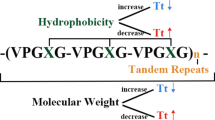Abstract
The genetic engineering of protein-based polymers is a method that enables, in an easy way, the design of complex and highly functional macromolecules. As examples of this approach, different molecular designs are presented, with increasing degree of complexity, showing how the controlled increase in their complexity yields (multi)functional materials with more selected and sophisticated properties. The simplest designs show interesting properties already, but the adequate introduction of given chemical functions along the polymer chain provides an opportunity to expand the range of properties to enhanced smart behavior and self-assembly. Finally, examples are given where those molecular designs further incorporate selected bioactivities in order to develop materials for the most cutting edge applications in biomedicine and nano(bio)technology.
Similar content being viewed by others
References
Alix AJ (2001) A turning point in the knowledge of the structure–function–activity relations of elastin. J Soc Biol 195:181–193
Alonso M, Reboto V, Guiscardo L, Mate V, Rodríguez-Cabello JC (2001) Novel photoresponsive p-phenylazobenzene derivative of an elastin-like polymer with enhanced control of azobenzene content and without pH sensitiveness. Macromolecules 34:8072–8077
Alonso M, Reboto V, Guiscardo L, San Martín A, Rodríguez-Cabello JC (2000) Spiropyran derivative of an␣elastin-like bioelastic polymer: photoresponsive molecular machine to convert sunlight into mechanical work. Macromolecules 33:9480–9482
Chilkoti A, Dreher MR, Meyer DE (2002) Design of thermally responsive, recombinant polypeptide carriers for targeted drug delivery. Adv Drug Deliver Rev 54:1093–1111
Di Zio K, Tirrell DA (2003) Mechanical properties of artificial protein matrices engineered for control of cell and tissue behavior. Macromolecules 36:1553–1558
Dreher MR, Raucher D, Balu N, Colvin OM, Ludeman SM, Chilkoti A (2003) Evaluation of an elastin-like polypeptide–doxorubicin conjugate for cancer therapy. J Control Release 91:31–43
Flamia R, Zhdan PA, Martino M, Castle JE, Tamburro AM (2004) AFM study of the elastin-like biopolymer poly(ValGlyGlyValGly). Biomacromolecules 5:1511–1518
Girotti A, Reguera J, Arias FJ, Alonso M, Testera AM, Rodríguez-Cabello JC (2004a) Influence of the molecular weight on the inverse temperature transition of a model genetically engineered elastin-like pH-responsive polymer. Macromolecules 37:3396–3400
Girotti A, Reguera J, Rodríguez-Cabello JC, Arias FJ, Alonso M, Testera AM (2004b) Design and bioproduction of a recombinant multi(bio)functional elastin-like protein polymer containing cell adhesion sequences for tissue engineering purposes. J Mater Sci Mater Med 15:479–484
Heilshorn SC, Liu JC, Tirrell DA (2005) Cell-binding domain context affects cell behavior on engineered proteins. Biomacromolecules 6:318–323
Herrero-Vanrell R, Rincón A, Alonso M, Reboto V, Molina-Martinez I, Rodríguez-Cabello JC (2005) Self-assembled particles of an elastin-like polymer as vehicles for controlled drug release. J Control Release 102:113–122
Liu JC, Heilshorn SC, Tirrell DA (2004) Comparative cell response to artificial extracellular matrix proteins containing the RGD and CS5 cell-binding domains. Biomacromolecules 5:497–504
Martino M, Perri T, Tamburro AM (2002) Biopolymers and biomaterials based on elastomeric proteins. Macromol Biosci 2:319–328
Miao M, Bellingham CM, Stahl RJ, Sitarz EE, Lane CJ, Keeley FW (2003) Sequence and structure determinants for the self-aggregation of recombinant polypeptides modeled after human elastin. J Biol Chem 278:48553–48562
Nicol A, Gowda DC, Parker TM, Urry DW (1994) Cell adhesive properties of bioelastic materials containing cell attachment sequences. In: Gebelein C, Carraher C (eds) Biotechnology and bioactive polymers. Plenum Press, New York
Panitch A, Yamaoka T, Fournier MJ, Mason TL, Tirrell DA (1999) Design and biosynthesis of elastin-like artificial extracellular matrix proteins containing periodically spaced fibronectin CS5 domains. Macromolecules 32:1701–1703
Reguera J, Fahmi A, Moriarty P, Girotti A, Rodríguez-Cabello JC (2004) Nanopore formation by self-assembly of the model genetically engineered elastin-like polymer [(VPGVG)2(VPGEG)(VPG VG)2]15. J␣Am Chem Soc 126:13212–13213
Richman GP, Tirrell DA, Asthagiri AR (2005) Quantitatively distinct requirements for signaling-competent cell spreading on engineered versus natural adhesion ligands. J Control Release 101:3–12
Rodríguez-Cabello JC, Alonso M, Guiscardo L, Reboto V, Girotti A (2002) Amplified photoresponse of a p-phenylazobenzene derivate of elastin-like polymer by a-Cyclodextrin: the amplified ΔT t mechanism. Adv Mater 14:1151–1154
Rodríguez-Cabello JC, Alonso M, Pérez T, Herguedas MM (2000) Differential scanning calorimetry study of the hydrophobic hydration of the elastin-based polypentapeptide, poly(VPGVG), from deficiency to excess of water. Biopolymers 54:282–288
Rodríguez-Cabello JC, Reguera J, Girotti A, Alonso M, Testera AM (2005) Developing functionality in elastin-like polymers by increasing their molecular complexity: the power of the genetic engineering approach. Prog Polym Sci 30:1119–1145
Shao Z, Vollrath F (2002) Surprising strength of silkworm silk. Nature 418:741
Urry DW (1990) Preprogrammed drug delivery systems using chemical triggers for drug release by mechanochemical coupling. Polym Mater Sci Eng 63:329–336
Urry DW (2005) What sustains life? Consilient mechanisms for protein-based machines and materials Springer-Verlag, LLC New York
Urry DW, Nicol A, Gowda DC, Hoban LD, McKee A, Williams T, Olsen DB, Cox BA (1993) Medical Applications of bioelastic materials. In: Gebelein CG (ed) Biotechnological polymers: medical, pharmaceutical and industrial applications, Technomic Publishing Co. Inc., Atlanta, Georgia, pp 82–103
Urry DW, Parker TM, Reid MC, Gowda DC (1991) Biocompatibility of the bioelastic materials, poly(GVGVP) and its gamma-irradiation cross-linked matrix: summary of generic biological test results. J␣Bioactive Comp Polymers 6:263–283
Welsh ER, Tirrell DA (2000) Engineering the extracellular matrix: a novel approach to polymeric biomaterials. I. Control of the physical properties of artificial protein matrices designed to support adhesion of vascular endothelial cells. Biomacromolecules 1:23–30
Wright ER, Conticello VP (2002) Self-assembly of block copolymers derived from elastin-mimetic polypeptide sequences. Adv Drug Deliver Rev 54:1057–1073
Acknowledgements
This work was supported by the “Junta de Castilla y León” (VA002/02), by the MCYT (MAT2000-1764-C02, MAT2001-1853-C02-01, MAT2003-01205 and MAT2004-03484-C02-01) and by the European Commission (Marie Curie Research Training Network BioPolySurf MRTN-CT-2004-005516).
Author information
Authors and Affiliations
Corresponding author
Rights and permissions
About this article
Cite this article
Arias, F.J., Reboto, V., Martín, . et al. Tailored recombinant elastin-like polymers for advanced biomedical and nano(bio)technological applications. Biotechnol Lett 28, 687–695 (2006). https://doi.org/10.1007/s10529-006-9045-3
Received:
Accepted:
Published:
Issue Date:
DOI: https://doi.org/10.1007/s10529-006-9045-3




